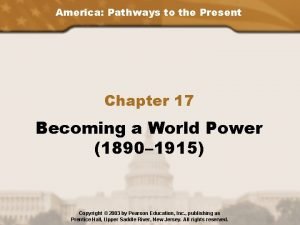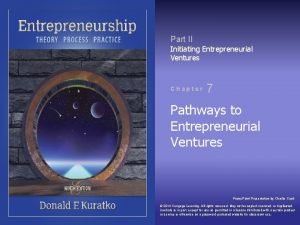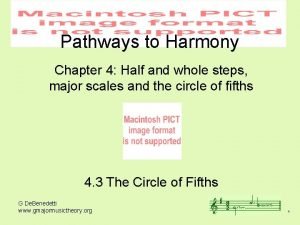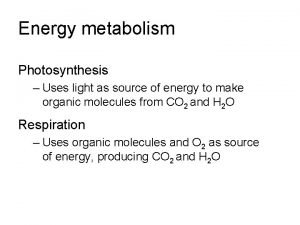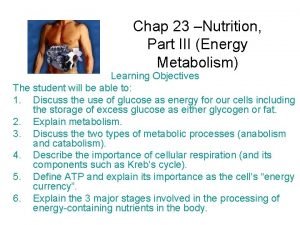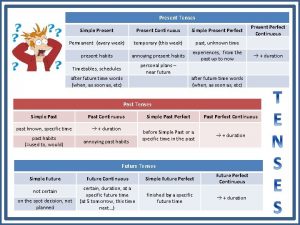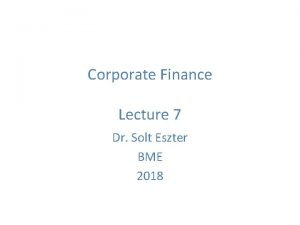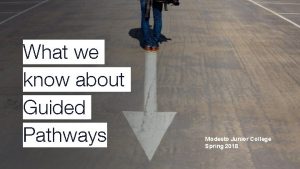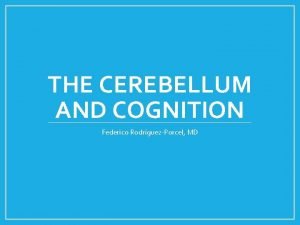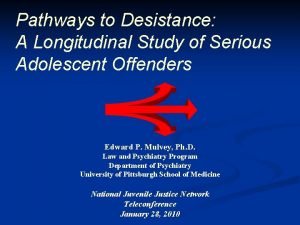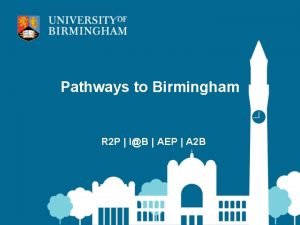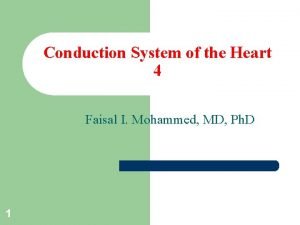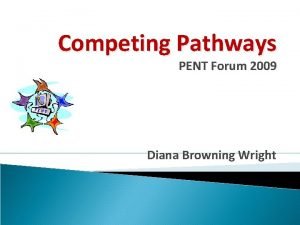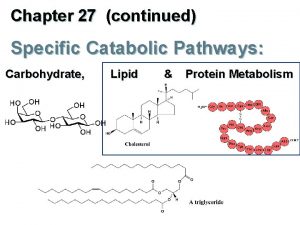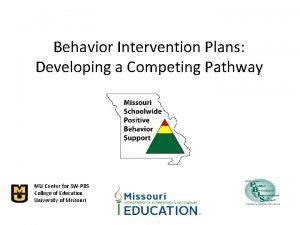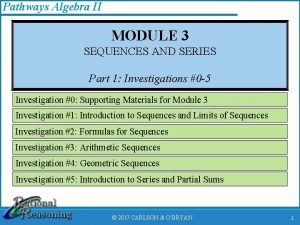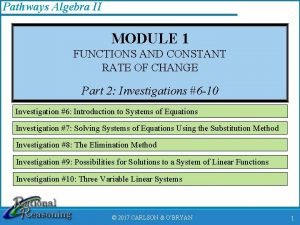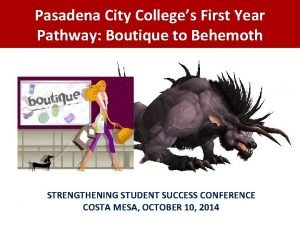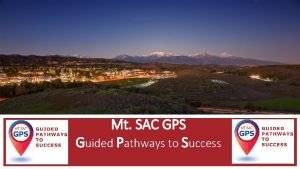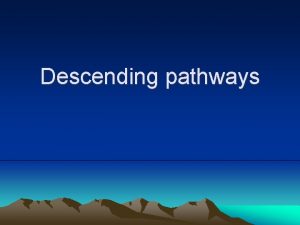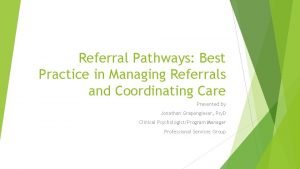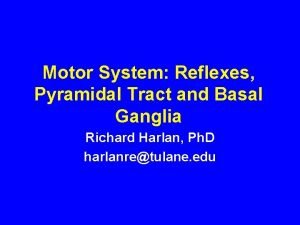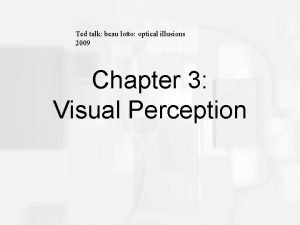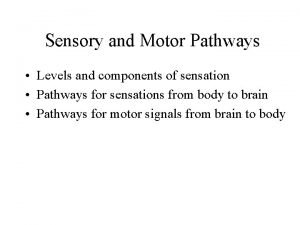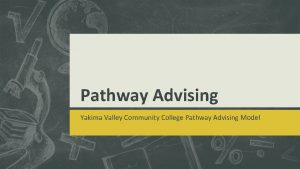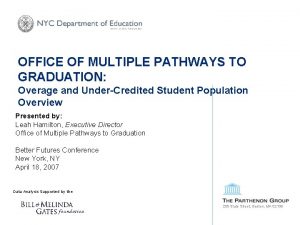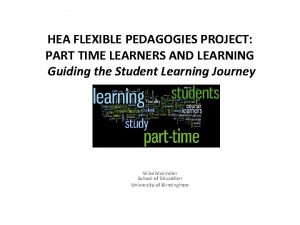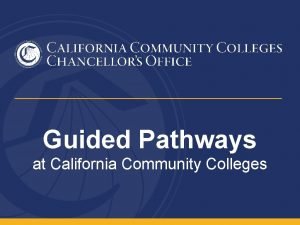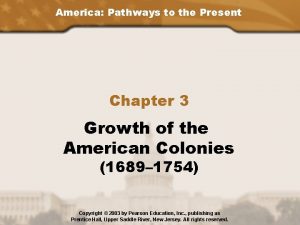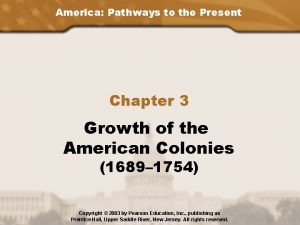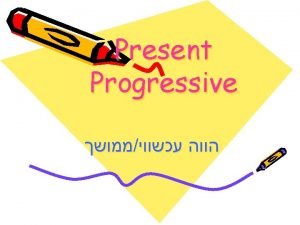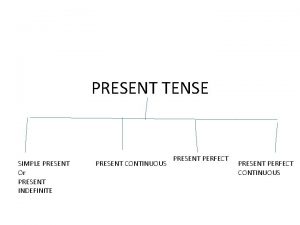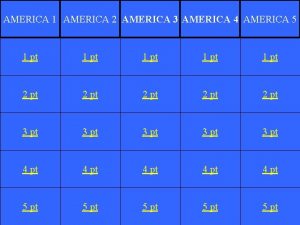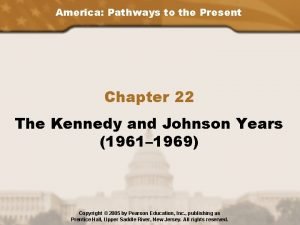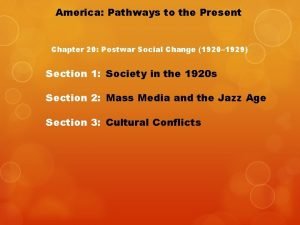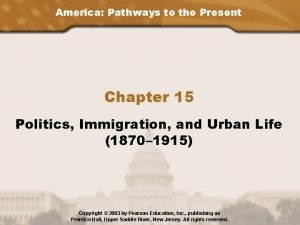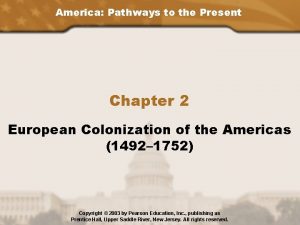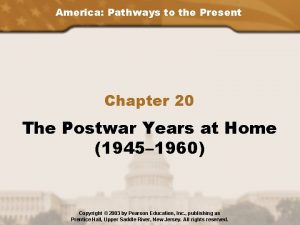America Pathways to the Present Chapter 3 Growth
























![Who benefitted? • “[The Navigation Acts] enabled merchants, manufacturers, shipbuilders and sailors to reap Who benefitted? • “[The Navigation Acts] enabled merchants, manufacturers, shipbuilders and sailors to reap](https://slidetodoc.com/presentation_image/1e092ac2dc62756cc3f8f6dd07799d03/image-25.jpg)




























































































































- Slides: 149

America: Pathways to the Present Chapter 3 Growth of the American Colonies (1689– 1754) Copyright © 2003 by Pearson Education, Inc. , publishing as Prentice Hall, Upper Saddle River, New Jersey. All rights reserved.

America: Pathways to the Present Chapter 3: Growth of the American Colonies (1689– 1754) Section 1: An Empire and Its Colonies Section 2: Life in Colonial America Section 3: African Americans in the Colonies Section 4: Emerging Tensions Copyright © 2003 by Pearson Education, Inc. , publishing as Prentice Hall, Upper Saddle River, New Jersey. All rights reserved.

An Empire and Its Colonies Chapter 3, Section 1 • How did the English Civil War affect the development of the colonies? • How did mercantilism influence England’s colonial laws and foreign policy? • What was Britain’s colonial policy in the early 1700 s? • What farming, trade, and settlement patterns defined the diverse economies of the colonies?

The Rights of Englishmen • “Even as the English began the settlement of the colonies in North America, England found itself enmeshed in political and religious conflict, in which ideas of liberty played a central role. The struggle over English liberty in the first half of the 17 th c. expanded the definition of freedom at home and spilled over into early English North America. ” (GML, p. 77) • By 1648, England found itself in a civil war.

The Rights of Englishmen • “By 1600, the traditional definition of ‘liberties’ as a set of privileges confined to one or another social group still persisted, but alongside it had arisen the idea that certain ‘rights of Englishmen’ applied to all within the kingdom. This tradition rested on the Magna Carta of 1215 which limited the power of the king to take arbitrary actions threatening certain rights and freedoms of the high nobles…But over time, the document came to be seen as embodying the idea of ‘English freedom’ that the king was subject to the rule of law, and that all persons should enjoy security of person and property. ” (GML, pgs. 77 -78)

English Civil War • In the 14 th century Parliament began as an informal council of nobles and bishops to advise the king. By the 16 th century, two houses of Parliament had emerged, the House of Lords and the House of Commons. While certainly not democratic by modern standards, since less than 10% of Englishmen could vote for members and far fewer could even qualify to serve, Parliament helped create the ideas of representative government and of a check on the executive. • By the early 17 th century, King James I and then Charles I were determined to rule without Parliament setting up a showdown in the late 1640 s.

The English Civil War Chapter 3, Section 1 • “The struggle for political supremacy between Parliament and the Stuart monarchs James I and Charles I culminated in the English Civil War of the 1640 s. ” • England’s Parliament was made up of representatives of the people. It had the power to make laws and approve new taxes. • King Charles I believed in divine right. • King Charles I demanded money from towns and cities without Parliament’s consent. Parliament saw this as an attempt to limit its power and the rights of English property owners. War broke out.

The English Civil War • Cavaliers v. Roundheads

Oliver Cromwell: “Lord Protector” • Parliament’s forces, known as the Roundheads defeated and executed King Charles in 1649. • The leader of Parliament, Oliver Cromwell, governed England as a dictator until his death in 1659. • In 1660, Parliament restored the monarchy by placing Charles II, the son of Charles I, on the throne. Parliament wanted stability.

England’s Debate Over Freedom • During the English Civil War new radical groups emerged that challenged both the monarchy and the aristocracy. • “The Levellers, history’s first democratic political movement called for a written constitution…abolishing the monarchy and the House of Lords and to greatly expand the right to vote. ”

England’s Debate Over Freedom • “…the Diggers went even further, hoping to give freedom an economic underpinning through the common ownership of land. ” • “Even before the restoration of the monarchy, the Levellers, Diggers, and other radical movements spawned by the English Civil War had been crushed or driven underground. ” (GML, . 79)

• The upper-middle and wealthy members of Parliament rushed to restore stability to England following Cromwell’s death. Movements like the Levellers and Diggers threatened their position. • Parliament invited the deposed king’s son back from exile to restore the monarchy (with Parilament’s consent).

The Restoration of the English Monarchy • With the restoration of the English monarchy in 1660 under Charles II, England expanded its colonial reach. It chartered new trading ventures, such as the Royal African Company, which was given a monopoly on the slave trade, and soon doubled the number of English colonies in North America.

English Liberty • “The political struggles in England elevated the notion of ‘English liberty’ to a central place in Anglo-American culture…. The medieval idea of liberties as a collection of entitlements enjoyed by specific groups did not suddenly disappear. But it was increasingly overshadowed by a more general definition of freedom grounded in the common rights of all individuals within the English realm…All Englishmen were governed by a king, but ‘he rules over free men, ’ according to the law, unlike the autocratic monarchs of France, Spain, Russia, and other countries. ” (GML, p. 79)

English Liberty • Henry Care’s 1680 book, English Liberties labels English system of government as a “‘Qualified Monarchy, ’ the best political structure in the world…” • “The belief in freedom as the common heritage of all Englishmen and the conception of the British Empire as the world’s guardian of liberty helped to legitimize English colonization in the Western Hemisphere and to cast its imperial wars against Catholic France and Spain as struggles between freedom and tyranny. ” (GML p. 82)

The Civil War and English America • “Struggles in England, with their vigorous discussion of the rights of freeborn Englishmen, inevitably reverberated in England’s colonies, dividing them from one another and internally. ” (GML, p. 82)

Creating Anglo-America, 1660 -1750 • “In the last quarter of the 17 th century, a series of crises rocked the European colonies of North America. Social and political tensions boiled over in sometimes ruthless conflicts between rich and poor, free and slave, settler and Indian, and members of different religious groups.

Creating Anglo-America, 1660 -1750 • At the same time struggles within and between European empires echoed in the American colonies. Aggrieved groups seized upon the language of freedom to advance their goals. Although each conflict had its own local causes, taken together they added up to a general crisis of colonial society in the area that would become the United States. ” (GML, p. 85)

Mercantilism Describe mercantilism (What it is, how it worked, why it was practiced? ) “As the New World became a battleground in European nations endless contests for wealth and power, England moved to seize control of Atlantic trade, solidify its hold on North America’s eastern coast, and exert greater control over its empire. By the middle of the 17 th century, it was apparent that the colonies could be an important source of wealth for the mother country. According to theory of mercantilism…

Mercantilism Describe mercantilism (What it is, how it worked, why it was practiced? ) • “According to the prevailing theory of ‘mercantilism, ’ the government should regulate economic activity so as to promote national power… • Above all, trade should be controlled so that more gold and silver flowed into the country than left it. That is exports of goods…should exceed imports…”

Mercantilsim • More wealth = more power

Mercantilism Describe mercantilism (What it is, how it worked, why it was practiced? ) • “In the mercantilist outlook, the role of colonies was to serve the interests of the mother country by producing marketable raw materials and importing manufactured goods from home. (GML, p. 87)

Mercantilism How did England implement mercantilism? Beginning under Cromwell, and then under King Charles II, Parliament enacted a series of Navigation Acts designed to wrest control of world trade from the Dutch and enjoy the profits arising from the English Empire.

Mercantilism How did England implement mercantilism? • “According to the Navigation Acts, certain ‘enumerated’ goods – essentially the most valuable colonial products, such as tobacco and sugar- had to be transported in English ships and sold initially in English ports, although they could then be re-exported to foreign markets. Similarly, most European goods imported into the colonies had to be shipped through England, where customs duties were paid. ” (GML, p. 87)
![Who benefitted The Navigation Acts enabled merchants manufacturers shipbuilders and sailors to reap Who benefitted? • “[The Navigation Acts] enabled merchants, manufacturers, shipbuilders and sailors to reap](https://slidetodoc.com/presentation_image/1e092ac2dc62756cc3f8f6dd07799d03/image-25.jpg)
Who benefitted? • “[The Navigation Acts] enabled merchants, manufacturers, shipbuilders and sailors to reap the Who benefitted benefits of colonial trade, and the government to enjoy added income from mercantilism? from taxes. ” • “As members of the empire, American colonies would profit as well, since their ships were considered English. Indeed, the Navigation Acts stimulated the rise of New England’s shipbuilding industry. ”

Who benefitted? • American farmers and planters had a ready market for their agricultural products. (England Who benefitted was always ready to buy from mercantilism? whatever they produced. ) • The English navy protected all commerce at no real cost to the colonists. • Both sides, therefore, benefitted.

Describe the political relationship between England the American colonies up through the end of the Civil War. • England largely left the colonies alone to govern themselves. • North America was 3, 000 miles across the Atlantic Ocean. • England could not maintain firm control over the distant wilderness America was. • England wanted to encourage settlement and giving colonies their “space” was one way. • Colonies early on developed forms of representative government. (House of Burgesses in Virginia in 1619. Mayflower Compact in 1620. New England town meetings. )

What steps did England take to reassert control after the Civil War? How did these measures fare? • Parliament implemented mercantilism by passed a series of Navigation Acts. • All colonial trade had to pass through England. • For the most part the colonies obeyed these laws since they, too, benefitted. • However, smuggling did occur, especially in New England.

The Restoration of the English Monarchy • With the restoration of the English monarchy in 1660 under Charles II, England expanded its colonial reach. It chartered new trading ventures, such as the Royal African Company, which was given a monopoly on the slave trade, and soon doubled the number of English colonies in North America.

England Seizes New Netherlands • The English seized New Netherland in 1664 as part of an Anglo-Dutch war that also resulted in the conquest of Dutch trading posts in Africa. England transformed the minor military post of New Netherlands into an important imperial seaport and military base for operations against the French. The colony now became New York.

The English Take the New Netherland Colony • English rule over New York expanded and constricted freedom for certain groups. The English promised to continue religious toleration and respect property holdings, but they eliminated some rights for married women and practices that benefited female colonists. The English also discriminated against free blacks who had previously enjoyed all the rights of other “freemen. ”

The English Take the New Netherland Colony English rule also for a time strengthened the Iroquois Confederacy in upstate New York. In the mid-1670’s, New York’s Governor, Sir Edmund Andros, formed an alliance with the Iroquois known as the Covenant Chain. This expanded English and Iroquois power in the Great Lakes and Ohio Valley regions at the expense of the French and their Indian allies.

New York is Born • At the same time, many English colonists began to complain that they were being denied their English liberties, particularly the right to consent to taxation. The Dutch in New Netherland had not had a representative assembly, and English rule began without one, either. In 1683, the Duke of York agreed to call an elected assembly, which soon drafted a Charter of Liberties and Privileges affirming traditional English religious and political rights.

Rivers were important to the Middle Colonies for many reasons.

The Founding of Carolina • In the 1660 s, 8 English proprietors who were awarded the right to establish a colony north of Florida by King Charles II, in order to check Spanish expansion, founded Carolina. Initially the sons of wealthy plantation owners in Barbados, Carolina colonists traded with local Indians, employed them in raids against the Spanish, and also raided Indian communities for a burgeoning trade in Indian slaves.

The Founding of Carolina • But in 1715, Yamasee and Creek Indians alarmed by their trading debts and English slave trader’s raids into their territories mounted a rebellion which, when crushed, resulted in the enslavement or expulsion into Spanish Florida of most of the Indian tribes. Slavery was fundamental to Carolina and made it the most hierarchical - and once rice plantation agriculture developed— the wealthiest of England’s North American colonies.

By 1732, England had five colonies in southern North America.

The beginnings of the Georgia Colony in 1732: • The proprietary colony was established to prevent the expansion of Spain’s Florida colony and as a refuge for English debtors. • Mostly settled by poor English traders, craft workers, and debtors. • Slavery and alcohol not allowed. (This was later repealed. ) • Founded by James Oglethorpe.

The Pennsylvania Colony was founded in 1682. • Started by William Penn, a wealthy Quaker who cultivated peace with the Indians. • Quaker beliefs: • no clergy leadership • women spiritually equal to men • pacifist―do not fight wars or bear arms • tolerate other faiths

William Penn and the Quakers

The “Holy Experiment” • Was Pennsylvania “The Best Poor Man’s Country”? • The last English colony established in the 1600 s was Pennsylvania. Its proprietor, William Penn, an advocate of religious toleration and spiritual freedom, intended the colony as a space for social harmony between European migrants escaping religious persecution and Indians. A devout member of the Society of Friends, known as the Quakers, Penn encouraged Quaker settlement and helped frame the colony’s liberal government, which established religious liberty and an elected assembly with broad suffrage.

Unlike other English leaders, Quaker William Penn bought land from the Indians.

Religious toleration in Pennsylvania • Penn envisioned his colony as a “holy experiment” to be governed on Quaker principles, including the equality of all persons (including women, blacks, and Indians) under God and the primacy of the Individual conscience.

Quaker Liberty • Penn and the colony’s Quakers treated the Indians with special consideration, making peace with them (Quakers were pacifists, and did not have militias), and taking pains to pay all Indian land claims. Above all, Penn emphasized religious freedom, which was ensured in 1682 in the colony’s Charter of Liberty.

Land in Pennsylvania • Penn formed an assembly elected by male taxpayers and freemen—either free immigrants with 100 acres of land or former indentured servants with 50 acres—thus giving the vote to a majority of the colony’s men. Penn also owned all the land sold it to settlers at low prices to encourage a broad distribution of landed wealth and social equality.

Land in Pennsylvania • How did greater freedom and opportunity for whites in Pennsylvania lead to less freedom for others? • Pennsylvania’s freedom attracted migrants from all over Europe. This made the colony prosperous, but also increased tensions with Indians as whites who were not Quakers and pacifists pushed into Indian territory. • It also fostered the growth of African slavery in southern colonies as more indentured servants chose to migrate to Pennsylvania rather than Virginia or Maryland.

Englishmen and Africans • While the English, like all other European colonists in the Americas, did not intend to rely on African slaves as a labor force, the growing demand for labor for tobacco cultivation in the Chesapeake region led planters there to turn to the transatlantic slave trade. • Starting as one form of un-free labor among several forms, slavery existed in all 13 colonies and became the main source of labor in the plantation-based southern economy by the late 17 th century. • (in a hurry, skip to slide #60)

Englishmen and Africans • White masters saw many advantages in using African slaves rather than white indentured servants: African slaves were not protected by English common law, their terms never expired, they did not become discontented landless men, as had so many former servants, their children were slaves, their skin color made it more difficult for them to escape, and they were accustomed to difficult agricultural work. Also, compared to Native American slaves, African slaves were already immune from many European diseases.

Englishmen and Africans • While the English did not have modern notions of “race”—in which humankind is divided into groups associated with skin color —or racism—-an ideology based on the idea that some races are inherently superior to others and entitled to rule over them—the English did view other peoples, such as the Irish, Native Americans, and Africans as uncivilized, pagan, and savage and animallike.

Englishmen and Africans • At the time, the English, like other Europeans, tended to divide humanity between those were either civilized or barbarian, or Christian or non-Christian. Yet Africans, because of their skin color, religion, and social practices were seen by the English as “enslaveable” in a way that poor Englishmen were not.

Slavery in History • Slavery has existed for almost all of human history. It was central to ancient Greece and Rome and survived in northern Europe among Germans, Vikings, and Anglo-Saxons after the Roman Empire’s collapse. Although slavery existed in the 1600 s in the Mediterranean and Africa, it was quite different from the plantation form of slavery that developed in the Americas, in which large numbers of slaves were brought together for very demanding agricultural labor under a single owner. The large numbers of slaves increased the dangers of slave rebellion and invited harsh discipline. Unlike in Africa, the death rate was higher, and African slaves who became free still had a skin color that whites associated with slavery, and thus were marked as unworthy of equality in a free society.

Demand for Sugar Increases demand for Slaves • The African slave trade became a major international and transatlantic business only in the 1600 s. Slavery developed first in the western hemisphere outside of North America. By 1600, Brazil (a Portuguese colony), had large sugar plantations worked by African slaves.

Slavery in the West Indies • By the end of the seventeenth century, the profits to be had from sugar had transformed English, Dutch, French, and Danish colonies in the West Indies from mixed economies with few slaves and small farms worked by white servants to those dominated by lucrative sugar plantations worked exclusively by African slaves. Sugar was the first good to be massmarketed to European consumers, and became the most important product of the British, French, and Portuguese empires.

Slavery and the Law • Compared to its rapid introduction in Brazil and the West Indies, slavery grew slowly in North America. English indentured servants constituted the majority of the labor force in the Chesapeake well into the 1680 s. The most significant line of division in this region in the seventeenth century was not between whites and blacks, but between white plantation owners who dominated politics and society and everyone else—small farmers, servants, and slaves.

Slavery and the Law • While Spain had liberal laws granting slaves various rights and the Catholic church often encouraged masters to free their slaves, the legal status of slaves in the English colonies was initially ambiguous and undeveloped. Beginning in 1619, small numbers of Africans were brought to the Chesapeake, and while they were almost certainly treated as slaves, some were freed after serving a term of years. But racial distinctions were codified into law from the beginning; one such early Virginia law barred blacks from serving in the militia. But in both Virginia and Maryland, free blacks could sue and testify in court, and some even acquired land purchased white servants and black slaves. Blacks and whites worked side by side in the region’s tobacco fields, occasionally ran away together, and established intimate relationships.

The Rise of Chesapeake Slavery • Though evidence shows that slaves were being held for life as early as the 1640 s, only in the 1660 s did Virginia and Maryland’s laws refer explicitly to slavery. As tobacco planting spread and labor demand increased, conditions facing black and white servants diverged. To encourage migration, colonial authorities tried to improve the status of white servants. Simultaneously, blacks’ opportunities for freedom were restricted. By 1680, ideas of racial difference were strongly reflected in these colonies’ laws, despite their small black population. New laws, for example, mandated that children of free and slave parents would have the legal status of the mother—ensuring that masters could profit from sexually abusing female slaves, since the child would become the master’s property.

Bacon’s Rebellion • The shift from white indentured servants to African slaves as the main plantation workforce was hastened in 1676 by Bacon’s Rebellion. Governor William Berkeley had long ruled Virginia through a corrupt regime, forged in alliance with a small elite of the colony’s wealthiest tobacco planters, giving his supporters the best lands as white settlement pushed inland. With all the best lands already taken by wealthy planters, an increasingly poor population of freed white servants and migrants found it harder to acquire land. Forced to settle frontier areas, these men were also disenfranchised in 1670 by a new law limiting the vote, once given to all adult men, to landowners.

The End of the Rebellion and its Consequences • In 1676, disgruntled frontier whites demanded that Berkeley exterminate or expel frontier Indians to make room for white settlers, but the governor, fearing war and profiting from the Indian trade, refused. Led by planter Nathaniel Bacon, small farmers, landless men, indentured servants and even some Africans who also demanded lower taxes and an end to elite rule waged war against the Indians and the colonial government. They plundered plantations and burned Jamestown to the ground before English warships helped quell the rebellion.

The End of the Rebellion and its Consequences • Virginia’s ruling elite consolidated their rule by both limiting democracy and expanding social opportunity for poorer whites. They reinforced property qualifications for voting, but also reduced taxes and adopted aggressive policies towards Indians to open up more western lands. Most important, tobacco planters more and more spurned potentially rebellious white servants for African slaves, making the Chesapeake region a society based on slavery.

A Slave Society • Between 1700 and 1750, blacks went from more than 10 percent to almost 50 percent of the colony’s population—and almost all were slaves. Several factors contributed to the growth of slavery in Virginia. In 1705, Virginia’s legislature adopted a new slave code, embedding white supremacy in law, clearly defining black slaves as property and sharply limiting the freedom of free and enslaved blacks. Virginia had shifted from being a “society with slaves, ” in which slavery was just one labor system among other systems, to a “slave society, ” in which slavery was central to the society and economy.

Notions of Freedom • Europeans, Indians, and Africans alike all feared enslavement. Slaves often tried to escape, and those who spoke or read English or were familiar with European culture sometimes contested their condition. Slaves continued to resist their masters even as legal avenues for freedom receded in the Chesapeake at the end of the seventeenth and beginning of the eighteenth centuries.

Why did slavery begin in British North America? • England, embarked on the colonization of the New World with the intention of relying on African slaves for the bulk of the labor force. But the incessant demand for workers spurred by the spread of tobacco cultivation eventually led the Chesapeake planters to turn to the transatlantic trade in slaves. ” • “Compared with indentured servants, slaves offered planters many advantages. • First, as Africans, they could not claim the protection of English common law.

Why did slavery begin in the English colonies? • “Compared with indentured servants, slaves offered planters many advantages. • As Africans, they could not claim the protection of English common law. • Slaves’ term of service never expired, and they could therefore never become a population of unruly landless men. • Nor could they eventually gain land the right to vote and thus be economic and political competition to the planter class.

Why did slavery begin…? • Their children were slaves, and their skin color made it more difficult for them to escape… • African men, unlike their Native American counterparts, were accustomed to intensive agricultural labor, and they had encountered many diseases known in Europe and developed resistance to them, so they were less likely to die from epidemics. ” (GML, p. 94) • Price of slaves dropped. • Number of people willing to indenture themselves dropped as conditions in Britain improved. • (In Chesapeake, Bacon’s Rebellion was important event…) • Massachusetts was actually the first colony to legalize slavery (1641).

What steps were taken by Charles II and James II to rein in the colonies? How did these measures fare? • “Shortly before his death, Charles II revoked the Mass. Charter, citing wholesale violations of the Navigation Acts. ” • “Hoping to raise more money from the colonies in order to reduce his dependence on Parliament, James II between 1686 and 1688 combined Connecticut, Plymouth, Massachusetts, NH, RI, NY, and E. and W. Jersey into a single super-colony, the Dominion of New England. It was ruled by Sir Edmund Andros, who did not have to answer to an elected assembly. ” • “These measures reinforced the impression that James II was an enemy of freedom. ” (GML, p. 103)

King Philip’s War • Bacon’s Rebellion was only one of many crises in the late seventeenthcentury colonial America. The year before, 1675, witnessed the beginning of a war in New England between Indians and colonists unprecedented in its scale, ferocity, and devastation. • An alliance of Indian tribes in southern New England attacked English farms and settlements encroaching on Indian territories. Wrongly believing that the Indians were led by the Wampanoag leader Metacom, whom they called King Philip, the far more numerous whites were unprepared for the assault. Suffering, by 1676, the destruction of nearly half of New England’s ninety towns, they retreated to the region’s coastline. The settlers, aided by loyal Indian tribes, mounted a counter-attack that, when combining combat with Indian warriors and the massacre and burning of Indian villages, killed Metacom and crushed the rebel natives, some of whom were sold into slavery in the West Indies.

Upheaval in New England • King Philip’s War, causing the deaths of 1, 000 of New England’s 52, 000 white settlers, and 3, 000 of its 20, 000 Indians, expanded whites’ access to land only by finally dispossessing the region’s Indians of theirs. • This war also took place in the midst of growing political turmoil in England between Parliament and the King, as well as at home as the English king laid his heavy hand upon the Puritan dominated New England colonies.

The Glorious Revolution • Upheaval in England also affected the colonies. In 1688, the struggle for control over English government between Parliament and the crown culminated in the Glorious Revolution, a bloodless event that finally established parliamentary supremacy and a Protestant succession to the throne. Under Charles II’s rule, Parliament had expanded its authority and powers, but his unpopular successor, James II, alienated much of England after claiming to rule by divine right and seeking religious toleration for Protestant Dissenters and Catholics.

The Glorious Revolution • Fearing that the throne would go to his Catholic son, English aristocrats invited William of Orange, a Dutch nobleman and husband to Mary, James II’s Protestant daughter, to assume throne in the name of English liberties. In 1688, James II fled before William’s invading army, and William and Mary took the throne. The Parliament soon enacted a Bill of Rights, giving the Parliament control over taxation and establishing individual rights like trial by jury.

The Glorious Revolution • This peaceful coup assured the perpetuation of England’s balanced constitutional monarchy, allowing English subjects at home and in the colonies to celebrate English Protestantism and “rights and liberties. ”

The Glorious Revolution • Before the Glorious Revolution, England’s rulers sought to reduce growing colonial autonomy within the empire. Charles II had revoked Massachusetts’ colonial charter for violations of the Navigation Act, which the Massachusetts legislature had earlier refused to recognize (because the colony, they alleged, had no direct representation in Parliament).

The Glorious Revolution • And by 1688 James II had combined the colonies of Connecticut, Plymouth, Massachusetts, New Hampshire, Rhode Island, East and West Jersey (Pennsylvania) into a single super-colony, the Dominion of New England, ruled by New York’s former governor, Sir Edmund Andros, who was unaccountable to any legislature. The actions of King James and Andros alienated many colonists.

Charles II and James II reassert control • “Andros’s rule threatened both English liberties and the church-state relationship at the heart of Puritan order. ” (GML, p. 104) • “In 1689, news of James II’s overthrow triggered rebellions in several American colonies. Rebellions broke out in Boston (Mass. ), Maryland, and New York.

Uprisings in Maryland New York • News of King James’s ouster in 1689 caused rebellions in several American colonies. Boston militia jailed Andros and other imperial officials, whereupon the New England colonies re-established their governments. In New York, rebels led by Jacob Leisler took control. Soon thereafter, Protestant rebels in Maryland overthrew the government of that colony’s Catholic proprietor, Lord Baltimore, successfully revoked the old charter and created a new, Protestant-dominated government.

Leisler’s Rebellion in New York • Leisler’s Rebellion was not as successful. Leisler’s government unintentionally divided the colony along ethnic and economic lines, causing strife between the Dutch majority and English minority and between poor rebels and the wealthy. Soon alienated Dutch merchants and prominent English colonists united against him and convinced King William to suppress Leisler, who was executed, and his regime. The rebellion and its suppression polarized New York politics for decades.

What was the impact of the Glorious Revolution in the colonies? • The Puritans and Separatists lost their charters. Massachusetts became a royal colony with its governor appointed by the king. Religious freedom for all Protestants was guaranteed and all Protestant landowners could vote for the colonial legislature. “The demise of the ‘New England way’ greatly benefitted non-Puritan merchants and large landowners, who came to dominate the new government. ” (GML, p. 105)

What was the impact of the Glorious Revolution in the colonies? • The colonies benefitted from Parliament’s supremacy over the King. The Board of Trade was set up in 1696 to regulate colonial affairs. It wrote laws for the colonies and could review laws passed by colonial assemblies. In actuality, the colonies strengthened their tradition of representative government. Moreover, in the colonists’ daily lives, local governments were far more influential. Colonial assemblies (legislatures) – most of which were modeled on the Parliament in London - became the most important law makers and tax leviers in the colonies. Governors, who had power on paper, depended on assemblies for their salaries. • Ironically, as freedom expanded so too did slavery.

Summary/Review Chapter 3, Section 1 Theory of Mercantilism Effects on War and Effects on Trade Laws Politics • A country should try • The Navigation Act • European to get and keep as tightened English countries fought much bullion, or gold control over colonial over territory and silver, as trade by requiring trade routes. possible. the colonies to sell • To achieve this, a certain goods only to • British rulers tightened controls country’s balance of England. over the American trade, or the • If colonists wanted to difference between sell goods to other colonies. King imports and exports, parts of the world, James II tried to should show more they had to pay a take direct control exports than imports. duty, or tax, on it. over New York and New England by creating the Dominion of New England. Anger in the Colonies • Colonists resented James’s grab for power. They were angry with the governor of the Dominion that James had appointed. When Parliament replaced James II with his daughter Mary and her husband William of Orange, New England citizens rebelled and ended the Dominion. • Massachusetts becomes royal colony.

Britain’s Colonial Policy in the By Late 1600 s and Early 1700 s Chapter 3, Section 1 Origins of Self-Government • In theory, the royal governors of the colonies had great power. In reality, the colonial legislatures held the most power. They created and passed laws regarding defense and taxation. They set salaries for royal officials and influenced appointments of local officials. Salutary Neglect • Britain allowed its colonies more freedom to govern themselves than other European nations did. This British policy, known as salutary neglect, had three causes: – England had a long tradition of strong local government and weak central power. – British government lacked the resources to enforce its wishes. – Britain gave the colonies freedom because the existing economy and politics served the British interests.

Effects of Glorious Revolution on New England • With the removal of Andros and the dissolution of the Dominion of New England, the English crown restored most colonies’ old charters. But Massachusetts received a new charter as a royal colony, which now incorporated Plymouth. The new charter made property ownership, not church membership, the qualification for voting in elections for the colony’s legislature, made the governor a crown appointee, and required religious toleration for all Protestant denominations. These measures ended the Puritan’s Bible Commonwealth, empowering non. Puritan merchants and large landowners and increasing anxiety among Puritans ever alert to the devil’s work.

Witchcraft Trials in Salem • Many Puritans, like other Europeans and colonial Americans in the seventeenth century, believed in magic, astrology, witchcraft, and other supernatural phenomena, and often interpreted natural events as having religious or otherworldly meaning. Witchcraft was punishable by hanging in Europe and the colonies, and occasionally individuals convicted of witchcraft had been hanged in New England. Most accused of witchcraft were women beyond childbearing age who were outspoken, economically independent, estranged from their husbands, or otherwise thought to violate gender norms. A witch’s powers were held to challenge God’s will and the stature of men as family heads and rulers of society.

Salem Witchcraft Trials • In 1691, in Salem, Massachusetts, initial accusations of witchcraft snowballed into a full-blown crisis, as more and more of the accused tried to save themselves by confessing and naming others as witches. The frenzy of accusations led to legal charges against nearly 150 persons, most of them women, and nineteen men and women were hanged. Massachusetts religious and civil authorities were aghast. They dissolved the Salem courts, and warned that courts should no longer accept testimony from those claiming to be possessed or accept the confessions and accusations of those facing execution. • The Salem witchcraft craze discredited the prosecution of witches and encouraged a greater interest among prominent colonists in finding scientific explanations for natural events.

Diverse Colonial Economies Chapter 3, Section 1 Southern Colonies • This economy was based on staple crops—crops that are in constant demand. • Staple crops included tobacco and rice, both grown on large plantations worked by slaves. Middle Colonies • The economy of the Middle Colonies was a mixture of farming and commerce. • Rich, fertile soil produced wheat, barley, and rye. • New York and Philadelphia supported the business of merchants, traders, and craftspeople. New England Colonies • The New England economy relied on “carrying trade. ” Merchants carried crops and goods from one place to another. • The business of trading goods between the Americas, Europe, and Africa, was called triangular trade.

An Empire and Its Colonies - Assessment Chapter 3, Section 1 Under theory of mercantilism, a country’s balance of trade should show (A) more imports than exports. (B) a balance of imports and exports. (C) more exports than imports. (D) an even number of trades. Which of these was not considered a staple crop in the 1700 s? (A) tobacco (B) rice (C) wool (D) wheat Want to link to the Pathways Internet activity for this chapter? Click here!

An Empire and Its Colonies - Assessment Chapter 3, Section 1 Under theory of mercantilism, a country’s balance of trade should show (A) more imports than exports. (B) a balance of imports and exports. (C) more exports than imports. (D) an even number of trades. Which of these was not considered a staple crop in the 1700 s? (A) tobacco (B) rice (C) wool (D) wheat Want to link to the Pathways Internet activity for this chapter? Click here!

Life in Colonial America Chapter 3, Section 2 • How was colonial society organized? • Why was wealth in land important? • What were some common trades and occupations in the colonies? • What rights and responsibilities did colonial women have? • What was the nature of work and education in the colonies?

What accounts for the exceptional pace and diversity of colonial development during the 18 th century? • “Probably the most striking characteristic of colonial American society was its sheer diversity…In the 18 th century, African and non-English European arrivals skyrocketed, while the number emigrating from England declined. (see Table 3. 1, GML, p. 107) • London believed colonial development bolstered the nation’s power and wealth, even though they did not want skilled workers and professionals to leave Britain.

What accounts for the exceptional pace and diversity of colonial development during the 18 th century? • 50, 000 convicts were sent to the Chesapeake to work in the tobacco fields. • Germans, 110, 000 in all, formed the largest group of newcomers from Europe. Germans tended to travel in families. Their migration enhanced the ethnic and religious diversity of the colonies. • From 1713 to 1754, five times as many slaves poured onto mainland North America as in all the preceding years. The proportion of blacks in the colonies doubled, rising from 11% in 1700 to 20% by mid-century.

What accounts for the exceptional pace and diversity of colonial development during the 18 th century? • Increasing religious toleration encouraged emigration. By the mid-18 th century, dissenting Protestants in most colonies had gained the right to worship as they pleased and own their churches… • The availability of land (and with it, in most cases, the right to vote) • The lack of a military draft. • Absence of restraints on economic opportunity. • Great demand for skilled workers. • Overall, much more freedom in the colonies attracted people. • Finally, high birth rates was the main reason for rapid population growth.

Colonial Society: The Colonial Elite Chapter 3, Section 2 • “Most free Americans benefitted from economic growth, but as colonial society matured an elite emerged that, while neither as powerful or wealthy as the aristocracy in England, increasingly dominated politics and society. Indeed, the gap between rich and poor probably grew more rapidly in the 18 th century than in any other period in American history. ” (GML, p. 118) • “In New England the Middle Colonies, expanding trade made possible the emergence of a powerful upper class of merchants, often linked by family or commercial ties to great trading firms in Britain…”

Colonial Society: The Colonial Elite Chapter 3, Section 2 • “By 1750, the colonies of the Chesapeake and Lower South were dominated by slave plantations producing staple crops…for the world market…planters accumulated great wealth. ” • “The colonial elite also included the rulers of proprietary colonies like Pennsylvania and Maryland. ” (GML, p. 118)

Colonial Society Chapter 3, Section 2 • America had no titled aristocracy as in Britain…But throughout American, men of prominence controlled colonial government. • American colonists brought many ideas and customs from Europe. Most colonists believed: – The wealthy were superior to the poor. – Men were superior to women. - Whites were superior to blacks.

Anglicization • “Rather than thinking of themselves as distinctly American, colonial elites became more an more English – a process historians call ‘Anglicization. ’” • “Wealthy Americans tried to model their lives on British etiquette and behavior…they sought to demonstrate their status and legitimacy by importing the latest British fashions and literature, sending their sons to Britain for education…” (GML, p. 119)

The South Carolina Aristocracy • “The richest group of mainland colonists were South Carolina planters. • “Like their Virginia counterparts, SC grandees lived a lavish lifestyle amid imported furniture, imported wines, silk clothing…” • “The wealth in SC was highly concentrated. The richest 10% of the colony owned half the wealth in 1770, the poorest quarter less than 2%. ” (GML, p. 119)

The Middle Ranks • “The large majority of free Americans lived between the extremes of wealth and poverty. Along with racial and ethnic diversity, what distinguished the mainland colonies from Europe was the wide distribution of land the economic autonomy of most ordinary free families. ” (GML, p. 122)

The Middle Ranks • “By the 18 th century, colonial farm families viewed land ownership almost as a right, the social precondition of freedom…A dislike of personal dependence and an understanding of freedom as not relying on others for a livelihood sank deep roots in British North America. These beliefs, after all, accorded with social reality-a wide distribution of property made economic independence part of the lived experience of large numbers of white colonists. ” (GML, p. 122)

Poverty in the Colonies • “At the other end of the social scale, poverty emerged as a visible feature of 18 th century colonial life. ’ • “Among free American, poverty was hardly as widespread as in Britain…but as the colonial population as expanded, access to land diminished rapidly, especially in long settled areas…. By midcentury, tenants and wage laborers were a growing presence in the Middle Colonies. ”

Poverty in the Colonies • “In the colonial cities, the number of propertyless wage earners steadily increased. In Boston, one-third of the population in 1771 had no property at all. ” (GML, p. 121) • “Attitudes and policies toward poverty in colonial America mirrored British precedents. The better-off colonists generally viewed the poor as lazy, shiftless, and responsible for their own plight. ” • Many poor were members of families headed by widowed or abandoned women. ” (GML, p. 121)

Colonial Society: The Colonial Elite Chapter 3, Section 2 • The differences between social ranks could be seen in colonial clothes, houses, and manners. • Ordinary people wore dresses or plain pants and shirts. • Gentry (“gentle folk” ) wore wigs, silk stockings, lace cuffs, and the latest fashions. • Gentry — men and women wealthy enough to hire others to work for them

Wealth in Land Chapter 3, Section 2 • For English colonists, land was the foundation for real wealth. Most landowners were white men. • In the 1700 s, gentry built mansions to display their wealth and filled them with fine furniture, silver, and porcelain. • In each colony, a small group of elite, landowning men dominated politics. • Yet, important to remember, while most men owned enough land to vote for their colonial representatives, they voted for the elite. In doing so, they limited themselves to voting for the wealthiest men in their colony.

Trades and Occupations Chapter 3, Section 2 Artisans • Young boys became apprentices, individuals placed under a legal contract to work for another person in exchange for learning a trade. • Artisans made silver products, cabinets, tinware, pottery, and glassware. Printers • Colonial printers were considered vital because they gathered and circulated local news and information. • Benjamin Franklin, one of America’s most famous printers, published Poor Richard’s Almanac. • An almanac is a book containing information such as calendars, weather predictions, and advice. Farmers • Farms in the colonies varied in size from large cash-crop plantations in the South to small, self-supporting farms in the Middle and New England Colonies. Fishermen • Fish was dried, salted, and shipped out from harbor cities. • Fishing became a strong industry and promoted the growth of shipbuilding. Indentured Servants • Many immigrants came to the colonies as indentured servants.

Colonial Women Chapter 3, Section 2 Women and the Law • Under English common law, a husband had complete control over his wife. Women could not – Own property. – Vote. – Hold office. – Serve on a jury. • Husbands were allowed to beat their wives. • “Free women were expected to devote their lives to being good wives and mothers” (GML, p. 123) Women’s Duties • Cooking • Gardening • Washing • Cleaning • Weaving cloth • Sewing • Assisting other women in childbirth • Training daughters to do all of the above

The Nature of Work Chapter 3, Section 2 • The goal of the colonial household was to be self-sufficient. Everyone in the household worked to produce food and goods. • Men grew crops, or made goods like shoes, guns, and candles. • Women ran the household and assisted with the crops. • Children helped both parents. • Self-sufficient — able to make everything needed to maintain itself

Colonial Education Chapter 3, Section 2 • During colonial times, children received very little formal education. • Because Puritans believed everyone should be able to read the Bible, the New England Colonies became early leaders in the development of public education. • In 1647, Massachusetts passed a law requiring towns to set up grammar schools for boys. Girls were expected to learn from their mothers at home. • Generally, only the wealthy attended college, where they trained to be lawyers or ministers. Harvard, Yale, and William and Mary were the only three colleges in the colonies until the 1740 s.

* • Go to new power point • “An Empire of Freedom” (slide 46)

The Colonial Press • “In British North America, the press expanded rapidly during the 18 th century. So did the number of political broadsides and pamphlets published, especially at election time. Widespread literacy created an expanded market for printed materials. By the eve of the Revolution, some ¾ of the free adult male population in the colonies (and over 1/3 of women) could read and write…” • The first continuously published colonial newspaper appeared in Boston 1704. • “…by the 1730, political commentary was widespread in the American press. ” (GML, pgs. 148 -149)

Freedom of the Press and its Limits • “The public sphere thrived on the free exchange of ideas. But free expression was not generally considered one of the ancient rights of Englishmen…Outside of Parliament, free speech had no legal protection. ” • “As for freedom of the press, governments on both sides of the Atlantic viewed this as extremely dangerous, partly because they considered ordinary citizens as prone to be misled by inflammatory printed materials…”

Freedom of the Press and its Limits • “But, until 1695, when an English law requiring the licensing of printed works before publishing expired, no printed work could legally be printed without a government license. ” • “After 1695, the government could not censor newspapers, books, and pamphlets before they appeared in print, although it continued to try to manage the press by direct payments to publishers and individual journalists. Authors and publishers could be prosecuted for ‘seditious libel’ – a crime that included defaming government officials – or punished for contempt. ”

Freedom of the Press and its Limits • “Elected assemblies, not governors, most frequently violated freedom of the press in colonial America. Dozens of publishers were hauled before assemblies and forced to apologize for comments regarding one or another member. If they refused, they were jailed. ” • “Colonial newspapers vigorously defended freedom of the press as a central component of liberty…”

The Trial of Zenger • “The most famous colonial court case involving freedom of the press demonstrated that popular sentiment opposed prosecutions for criticism of public officials. This was the 1735 trial of John Peter Zenger. ” • “Zenger’s newspaper…lambasted the governor for corruption, influence peddling, and ‘tyranny. ’” • Zenger was arrested for seditious libel.

The Trial of Zenger • “The judge instructed the jurors to consider only whether Zenger had actually published the offending words, not whether they were accurate. But Zenger’s attorney urged the jury to judge not the publisher, but the governor. If they decided that Zenger’s charges were correct, they must acquit him. ” • “Zenger was found not guilty. The case sent a warning to prosecutors that libel cases might be difficult to win…” • “…the outcome helped promote the idea that the publication of truth should always be permitted, and it demonstrated that the idea of free expression was becoming ingrained in popular imagination. ” (GML, p. 150)

Life in Colonial America - Assessment Chapter 3, Section 2 “Gentle folk” was a colonial term for (A) ministers. (B) the gentry. (C) senior citizens. (D) midwives. Which of these would not be found in an almanac? (A) Calendars (B) Weather predictions (C) News stories (D) Wise sayings Want to link to the Pathways Internet activity for this chapter? Click here!

Life in Colonial America - Assessment Chapter 3, Section 2 “Gentle folk” was a colonial term for (A) ministers. (B) the gentry. (C) senior citizens. (D) midwives. Which of these would not be found in an almanac? (A) Calendars (B) Weather predictions (C) News stories (D) Wise sayings Want to link to the Pathways Internet activity for this chapter? Click here!

African Americans in the Colonies Chapter 3, Section 3 • What was the Middle Passage? • How did the experience of slavery differ from colony to colony? • What restrictions did free blacks face? • How did laws attempt to control slaves and prevent revolts?

Slavery’s Beginnings How did slavery begin in the English Colonies? • “No European nation, including England, embarked on the colonization of the New World with the intention of relying on African slaves for the bulk of the labor force. But the incessant demand for workers spurred by the spread of tobacco cultivation eventually led the Chesapeake planters to turn to the transatlantic trade in slaves. ” • “Compared with indentured servants, slaves offered planters many advantages. • First, as Africans, they could not claim the protection of English common law.

How /why did slavery begin in the English colonies? • “Compared with indentured servants, slaves offered planters many advantages. • As Africans, they could not claim the protection of English common law. • Slaves’ term of service never expired, and they could therefore never become a population of unruly landless men. • Nor could they eventually gain land the right to vote and thus be economic and political competition to the planter class.

WHY? • How /why did slavery begin in the English colonies? • • Their children were slaves, and their skin color made it more difficult for them to escape… African men, unlike their Native American counterparts, were accustomed to intensive agricultural labor, and they had encountered many diseases known in Europe and developed resistance to them, so they were less likely to die from epidemics. ” (GML, p. 94) Price of slaves dropped. Number of people willing to indenture themselves dropped as conditions in Britain improved. (In Chesapeake, Bacon’s Rebellion was important event…)

The Middle Passage Chapter 3, Section 3 • The Middle Passage was one leg of the triangular trade between the Americas, Europe, and Africa. This term also refers to the forced transport of slaves from Africa to the Americas. • Roughly 10 to 40 percent of Africans on slave trips died in the crossing. Slaves were beaten and had to endure chains; heat; and cramped, unsanitary conditions. • Occasionally enslaved Africans staged a mutiny, or revolt, on the slave ships. Many of these were successful.

Chesapeake Slavery • What were the major varieties of African slavery in 18 th century British America? • “By the mid-18 th century, three distinct slave systems were well entrenched in Britain’s mainland colonies: tobaccobased plantation slavery in the Chesapeake, rice-based plantation slavery in South Carolina and Georgia, and nonplantation slavery in New England the Middle Colonies. ” • “The largest and oldest of these was the tobacco plantation system of the Chesapeake, where more than 270, 000 slaves resided in 1770, nearly half of the region’s population. ”

Chesapeake Slavery • “One the eve of the Revolution, VA and MD were as closely tied to Britain as any other colonies and their economies were models of mercantilist policy…In the 18 th century, the growing world demand for tobacco encouraged continued slave imports…” • “As Virginia shifted westward, so did slavery…”

Chesapeake Slavery • “Most Chesapeake slaves toiled in the fields, but thousands labored as teamsters, as boatmen, and in skilled crafts…Numerous slave women became cooks, seamstresses, dairy maids, and personal servants. ” • “Slavery was common on small farms as well as plantations…Nearly half of Virginia’s white families owned at least one slave in 1770”

Chesapeake Slavery • • “Slavery laid the foundation for the consolidation of the Chesapeake elite, a landed gentry that, in conjunction with merchants who handled the tobacco trade and lawyers who defended the interests of slaveholders, dominated the region’s society and politics. ” “Meanwhile, even as the consumer revolution improved the standard of living of lesser whites, their long-term economic prospects diminished. As slavery expanded, planters engrossed the best lands and wealth among the white population became more and more concentrated. ”

Chesapeake Slavery • “Slavery transformed Chesapeake society into a hierarchy of degrees of freedom. ” (GML, p. 132) • “…planters filled the law books with measures enhancing the master’s power over his human property and restricting blacks’ access to freedom” “Race took on more and more importance as a line of social division. Whites increasingly considered free blacks dangerous and undesirable. Free blacks lost the right to employ white servants and to bear arms, were subjected to special taxes, and could be punished for striking a white person, regardless of the cause. In 1732, Virginia revoked the voting privileges of propertyowning free blacks. ” (GML, pgs. 132 -133) •

South Carolina and Georgia: The Rice Kingdom • “Farther south, a different slave system, based on rice production, emerged in South Carolina and Georgia. ” • “The English Barbadians who initially settled SC in the 1670 s were quite familiar with African slavery, but their first victims were members of the area’s native population…” • “The local Creek Indians initially welcomed the settlers and began selling them slaves, generally war captives and their families, most of whom were sold to the West Indies…As the plantation system expanded, however, the Creeks became more and more concerned, not only because it led to encroachment on their land, but because they feared enslavement themselves. ” (GML, p. 134)

South Carolina and Georgia: The Rice Kingdom • “Ironically, it was Africans, familiar with the crop at home, who taught English settlers how to cultivate rice, which became the foundation of SC slavery and of the wealthiest slaveholding class on the North American mainland. ” • “…SC planters owned far more land slaves than their counterparts in Virginia. ” • “In the Chesapeake, field slaves worked in groups under constant supervision. Under the ‘task’ system that developed in 18 th century SC, individual slaves were assigned daily jobs, the completion of which allowed them time for leisure or to cultivate crops of their own. ”

The Georgia Experiment • “Initially, the proprietors banned the introduction of both alcohol and slaves, leading to continued battles with settlers, who wanted both. By the 1740 s, Georgia offered the spectacle of colonists pleading for the ‘English liberty’ of self-government so that they could enact laws introducing slavery. In 1751, the proprietors surrendered the colony to the Crown…” • “The elected assembly repealed the ban on liquor and slavery, as well as an early measure that had limited land holdings to 500 acres. Georgia became a miniature version of SC. ” (GML, pgs. 134 -135)

Slavery in the North • “Compared to the plantation regions, slavery was far less central to the economies of New England the Middle Colonies, where small farms predominated. Slaves represented only a minor part of these colonies populations, and it was unusual for even rich families to own more than one slave…Nonetheless, slavery was not entirely marginal to northern colonial life. ” • “Slaves worked as farm hands, in artisan shops, as stevedores loading and unloading ships, and as personal servants. ”

Slavery in the North • “In the early 18 th century, at least ¾ of the urban elite owned at least one slave. But with slaves so small a part of the population that they seemed to pose no threat to the white majority, laws were less harsh than in the South. ” • “In New England, where in 1770 the 17, 000 slaves represented less than 3% of the population, slave marriages were recognized in law, the severe punishment of slaves was prohibited, and slaves could bring suits in court, testify against whites, and own property and pass it on to their children – rights unknown in the South. ” (GML, p. 135)

Slavery in the North • “Slavery had been present in NY from the earliest days of Dutch settlement. With white immigration lagging far behind that of PA, the colony’s Hudson landlords, small farmers, and craftsmen continued to employ considerable amounts of slave labor in the 18 th century. ” • “As NYC’s role in the slave trade expanded, so did slavery in the city. In 1746, its 2, 440 slaves amounted to one-fifth of NYC’s total population. Some 30% of its labor-force were slaves, a proportion second only to Charleston among American cities. ” • “Slavery was also a significant presence in Philadelphia…(GML, p. 136)

Slavery in the Colonies Chapter 3, Section 3 South Carolina and Georgia • High temperatures and disease made slave conditions especially harsh in this region. • African Americans made up the majority of the population in South Carolina and more than one third of Georgia’s population. • Southern slaves kept their culture alive through their speech, crafts, and music. Virginia and Maryland • Slaves in Virginia and Maryland made up a minority of the population. • Few of those slaves came directly from Africa. • Slaves had other tasks in addition to growing crops. • There was more integration of European American and African American cultures than in South Carolina and Georgia. • To save money, slaveowners encouraged slaves to have families. New England the Middle Colonies • There were far fewer slaves in New England the Middle Colonies than in the South. • Slaves had more freedom to choose their occupations. • Slaves in this region typically worked as cooks, housekeepers, and personal servants. They also worked as skilled artisans, dockworkers, merchant sailors, fishermen, whalers, privateers, lumberjacks, and in manufacturing.

Estimated African American Population, 1690 – 1750 Chapter 3, Section 3 Year New England Colonies Middle Colonies Southern Colonies 1690 950 2, 472 13, 307 1700 1, 680 3, 661 22, 476 1710 2, 585 6, 218 36, 063 1720 3, 956 10, 825 54, 058 1730 6, 118 11, 683 73, 220 1740 8, 541 16, 452 125, 031 1750 10, 982 20, 736 204, 702 SOURCE: Historical Statistics of the United States, Colonial Times to 1970

Free Blacks Chapter 3, Section 3 • Slaves that earned money as artisans or laborers had the possibility of saving enough to purchase their freedom. Free African Americans did the same kind of work as enslaved African Americans, but were often worse off economically and socially. • Free blacks faced poorer living conditions and more discrimination than slaves who were identified with specific white households. • Free blacks could not vote, testify in court, or marry whites.

Laws and Revolts Chapter 3, Section 3 Laws • Slaves could not go aboard ships or ferries, or leave the town limits without a written pass. • Slaves could be accused of crimes ranging from owning hogs or carrying canes to disturbing the peace or striking a white person. • Punishments included whipping, banishment to the West Indies, and death. Revolts • In the Stono Rebellion, several dozen slaves in South Carolina killed more than 20 whites. The rebels were captured and killed. • New York City had slave rebellions in 1708, 1712, and 1741. After the 1741 revolt, 13 African Americans were burned alive as punishment. • African Americans undertook almost 50 documented revolts between 1740 and 1800.

African Americans in the Colonies Assessment Chapter 3, Section 3 Which term refers to the forced transport of slaves from Africa to the Americas? (A) The Underground Railroad (B) The Northwest Passage (C) Tobacco Row (D) The Middle Passage In which colony did African Americans make up the majority of the population? (A) South Carolina (B) Massachusetts (C) Virginia (D) Georgia Want to link to the Pathways Internet activity for this chapter? Click here!

African Americans in the Colonies Assessment Chapter 3, Section 3 Which term refers to the forced transport of slaves from Africa to the Americas? (A) The Underground Railroad (B) The Northwest Passage (C) Tobacco Row (D) The Middle Passage In which colony did African Americans make up the majority of the population? (A) South Carolina (B) Massachusetts (C) Virginia (D) Georgia Want to link to the Pathways Internet activity for this chapter? Click here!

Emerging Tensions Chapter 3, Section 4 • What drove the western expansion of colonial settlement? • How did Native Americans and the French react to the expansion of the colonies? • Why did the Great Awakening both resolve and contribute to religious tensions?

Western Expansion Chapter 3, Section 4 • In the mid-1700 s, the colonial population was increasing rapidly, nearly doubling every 25 years. • Birth rates were rising. • Immigrants from England, Ireland, Germany, and other countries were settling in colonial America. • As the population grew, settlers pushed west in search of more land. These settlers were part of a migration, or movement, in search of land on which they could build independent lives and maintain their households. • Immigrants — people who enter a new country to settle

Native American and French Reaction Chapter 3, Section 4 Native American Response • As white settlers migrated into Indian territory, the Indians were forced to relocate into lands already occupied by other Native American groups. • The Cherokees, Creeks, Chickasaws, and Choctaws put up a powerful struggle to block westward colonial expansion. French Actions • In 1752, the French built Fort Presque Isle in Pennsylvania and attacked and killed the men defending an English trading post in the Ohio Valley. • By the early 1750 s, it became clear that Pennsylvania would become the setting for a struggle between the colonists, Native Americans, and the French.

The Enlightenment • • American intellectuals, like Benjamin Franklin, were much influenced by the ideals of the 18 th century Enlightenment thinkers emphasized reason, progress, science, and the capacity for human improvement. Some Enlightenment figures were Deists – that is, they believed in a god who created a universe and set it in motion according to natural laws discoverable by human intellect but did not intervene thereafter with miracles. Deists such as Franklin and Thomas Jefferson, while formally considering themselves Christian and attending church, disliked zealots who persecuted others in the name of religion. “Enlightenment thinkers insisted that every human institution, authority, and tradition be judged before the bar of reason…They sought to apply to political and social life the scientific method of careful investigation based on research and experiment” (GML, pgs. 150 -151)

Religious Tensions Chapter 3, Section 4 • The British colonies were primarily Protestant. – Southern planters, northern merchants, and northern professionals tended to belong to the Church of England. – Most New Englanders were either Congregationalists or Presbyterians. – Quakers, Lutherans, and Mennonites were common in Pennsylvania. – The Dutch Reformed Church thrived in the colonies of New York and New Jersey.

What was the Great Awakening, what gave rise to it, and what impact did it have on colonial America? • “Many ministers were concerned that westward expansion, commercial development, the growth of Enlightenment rationalism, and lack of individual engagement in church services was undermining religious devotion. These fears helped to inspire the revivals that swept through the colonies beginning in the 1730 s. ” • “Known as the Great Awakening, the revivals were less a coordinated movement than a series of local events united by a commitment to a ‘religion of the heart, ’ a more emotional and personal Christianity than that offered by existing churches. ” (GML, p. 152)

The Great Awakening Sparks Religious Revivals • “During the 1720 s and 1730 s, the NJ Dutch Reformed clergyman Theodore Frelinghuysen, his Presbyterian neighbors William and Gilbert Tennent, and the Massachusetts Congregationalist minister Jonathan Edwards pioneered an intensely emotional style of preaching…” • “Only a ‘new birth’ – immediately acknowledging one’s sins and pleading for divine grace – could save men from eternal damnation. ”

The Great Awakening Sparks Religious Revivals • “Religious emotionalism was not confined to the American colonies – it spread through much of mid-18 th century Europe as well. More than any other individual, the English minister George Whitefield, sparked the Great Awakening…God. Whitefield proclaimed was merciful. Rather than being predestined for damnation, men and women could save themselves by repenting of their sins. ” • “Tens of thousands of colonists flocked to Whitefield’s sermons, which were widely reported in the American press…” • “Whitefield had inspired the emergence of numerous Dissenting churches… ‘New Lights’ vs. ‘Old Lights’” (GML, pgs. 152 -153)

The Awakening’s Impact • “Although the revivals were primarily a spiritual matter, the Great Awakening reflected existing social tensions, threw into question many forms of authority, and inspired criticism of all aspects of colonial society. They attracted primarily men and women of modest means…” • “…the impact of the Great Awakening spread beyond purely spiritual matters. The newspaper and pamphlet wars it inspired greatly expanded the circulation of printed materials in the colonies. ”

The Awakening’s Impact “The revivals encouraged many colonists to trust their own views rather than those of established elites…” • “The revivalists’ aim was spiritual salvation, not social or political revolution. But the independent frame of mind they encouraged would have significant political consequences. ” (GML, p. 154) • Ironically, the very different Enlightenment and Great Awakening had similar outcomes. Both stressed individualism and inspired challenges to authority.

The Great Awakening Chapter 3, Section 4 • The Great Awakening refers to a revival of religious feeling that began in the early 1700 s. These revivals were designed to renew religious enthusiasm and commitment. • Jonathan Edwards — Edwards, a Massachusetts minister, is believed to have started the Great Awakening. His success inspired other ministers to increase their efforts to energize their followers. • George Whitefield — Whitefield was an itinerant, or traveling, preacher who toured the colonies seven times between 1738 and 1770. • These ministers preached that any Christian could have a personal relationship with Jesus Christ. They stated that faith and sincerity, rather than wealth and education, were the major requirements needed to understand the Gospel.

Churches Reorganize Chapter 3, Section 4 • In the 1740 s and 1750 s, many New Englanders converted to the Baptist faith. • In the South, both the Baptist and the Methodist churches drew many followers through their powerful, emotional ceremonies and their celebration of ordinary people. • Revivals caused several churches to break apart. While some embraced the new emotionalism, others rejected it. • Some of the splinter groups were more tolerant of dissent than the organizations from which they split. • Dissent — difference of opinion

Emerging Tensions - Assessment Chapter 3, Section 4 To migrate is to (A) sleep all winter. (B) move in search of land. (C) change religion. (D) divide a parcel of land among heirs. The Great Awakening was a (A) civil rights movement. (B) new awareness of the opportunities out West. (C) treaty between the French and Native Americans. (D) religious movement. Want to link to the Pathways Internet activity for this chapter? Click here!

Emerging Tensions - Assessment Chapter 3, Section 4 To migrate is to (A) sleep all winter. (B) move in search of land. (C) change religion. (D) divide a parcel of land among heirs. The Great Awakening was a (A) civil rights movement. (B) new awareness of the opportunities out West. (C) treaty between the French and Native Americans. (D) religious movement. Want to link to the Pathways Internet activity for this chapter? Click here!
 Prentice hall america pathways to the present
Prentice hall america pathways to the present Rap of the map of the us
Rap of the map of the us America 2 europe
America 2 europe Whats an onomatopeia
Whats an onomatopeia Why called latin america
Why called latin america Eu amo a américa e a américa me ama
Eu amo a américa e a américa me ama Plant growth analysis
Plant growth analysis Pith
Pith Carothers equation
Carothers equation Primary growth and secondary growth in plants
Primary growth and secondary growth in plants Chapter 35 plant structure growth and development
Chapter 35 plant structure growth and development Geometric growth vs exponential growth
Geometric growth vs exponential growth Neoclassical growth theory vs. endogenous growth theory
Neoclassical growth theory vs. endogenous growth theory Organic growth vs inorganic growth
Organic growth vs inorganic growth Pathways to entrepreneurial ventures
Pathways to entrepreneurial ventures Pathways to harmony chapter 1 answers
Pathways to harmony chapter 1 answers Pathways to harmony chapter 1 answers
Pathways to harmony chapter 1 answers Chapter 7 a closer look energy metabolism pathways
Chapter 7 a closer look energy metabolism pathways Chapter 7 a closer look energy metabolism pathways
Chapter 7 a closer look energy metabolism pathways Present perfect present simple present continuous
Present perfect present simple present continuous Present perfect continuous affirmative
Present perfect continuous affirmative Present perfect simple and continuous romana
Present perfect simple and continuous romana Simple present present perfect present progressive noredink
Simple present present perfect present progressive noredink Wish in present
Wish in present Present simple present continuous present perfect
Present simple present continuous present perfect Present simple present continuous and present perfect
Present simple present continuous and present perfect Hình ảnh bộ gõ cơ thể búng tay
Hình ảnh bộ gõ cơ thể búng tay Slidetodoc
Slidetodoc Bổ thể
Bổ thể Tỉ lệ cơ thể trẻ em
Tỉ lệ cơ thể trẻ em Voi kéo gỗ như thế nào
Voi kéo gỗ như thế nào Thang điểm glasgow
Thang điểm glasgow Hát lên người ơi alleluia
Hát lên người ơi alleluia Các môn thể thao bắt đầu bằng tiếng bóng
Các môn thể thao bắt đầu bằng tiếng bóng Thế nào là hệ số cao nhất
Thế nào là hệ số cao nhất Các châu lục và đại dương trên thế giới
Các châu lục và đại dương trên thế giới Công thức tính thế năng
Công thức tính thế năng Trời xanh đây là của chúng ta thể thơ
Trời xanh đây là của chúng ta thể thơ Mật thư anh em như thể tay chân
Mật thư anh em như thể tay chân Phép trừ bù
Phép trừ bù Phản ứng thế ankan
Phản ứng thế ankan Các châu lục và đại dương trên thế giới
Các châu lục và đại dương trên thế giới Thơ thất ngôn tứ tuyệt đường luật
Thơ thất ngôn tứ tuyệt đường luật Quá trình desamine hóa có thể tạo ra
Quá trình desamine hóa có thể tạo ra Một số thể thơ truyền thống
Một số thể thơ truyền thống Cái miệng nó xinh thế chỉ nói điều hay thôi
Cái miệng nó xinh thế chỉ nói điều hay thôi Vẽ hình chiếu vuông góc của vật thể sau
Vẽ hình chiếu vuông góc của vật thể sau Nguyên nhân của sự mỏi cơ sinh 8
Nguyên nhân của sự mỏi cơ sinh 8 đặc điểm cơ thể của người tối cổ
đặc điểm cơ thể của người tối cổ Thế nào là giọng cùng tên
Thế nào là giọng cùng tên Vẽ hình chiếu đứng bằng cạnh của vật thể
Vẽ hình chiếu đứng bằng cạnh của vật thể Phối cảnh
Phối cảnh Thẻ vin
Thẻ vin đại từ thay thế
đại từ thay thế điện thế nghỉ
điện thế nghỉ Tư thế ngồi viết
Tư thế ngồi viết Diễn thế sinh thái là
Diễn thế sinh thái là Dạng đột biến một nhiễm là
Dạng đột biến một nhiễm là Số nguyên là gì
Số nguyên là gì Tư thế ngồi viết
Tư thế ngồi viết Lời thề hippocrates
Lời thề hippocrates Thiếu nhi thế giới liên hoan
Thiếu nhi thế giới liên hoan ưu thế lai là gì
ưu thế lai là gì Khi nào hổ mẹ dạy hổ con săn mồi
Khi nào hổ mẹ dạy hổ con săn mồi Sự nuôi và dạy con của hươu
Sự nuôi và dạy con của hươu Hệ hô hấp
Hệ hô hấp Từ ngữ thể hiện lòng nhân hậu
Từ ngữ thể hiện lòng nhân hậu Thế nào là mạng điện lắp đặt kiểu nổi
Thế nào là mạng điện lắp đặt kiểu nổi Present value of growth opportunities
Present value of growth opportunities Pathways modesto
Pathways modesto Nycte
Nycte Corticospinal tract
Corticospinal tract South forsyth high school pathways
South forsyth high school pathways Sdsu adt
Sdsu adt Lambert high school pathways
Lambert high school pathways Pathways to desistance
Pathways to desistance Pathways to birmingham partner school
Pathways to birmingham partner school Pathways planner
Pathways planner Internodal pathways
Internodal pathways Megan caposell
Megan caposell All metabolic pathways
All metabolic pathways German education system
German education system Base excision repair vs mismatch repair
Base excision repair vs mismatch repair Corticospinal tract function
Corticospinal tract function Internodal pathway
Internodal pathway Competing pathways chart
Competing pathways chart Palcahol
Palcahol Catabolic pathways
Catabolic pathways Organic chemistry reaction pathways
Organic chemistry reaction pathways Internodal pathways
Internodal pathways Competing behaviors examples
Competing behaviors examples Where is the av node located?
Where is the av node located? Apsva math pathways
Apsva math pathways Sas curriculum pathways
Sas curriculum pathways Virginia equity math
Virginia equity math Verizon career pathways
Verizon career pathways Upskilling pathways
Upskilling pathways Ward and siegert's pathways model
Ward and siegert's pathways model Pathways pediatric therapy
Pathways pediatric therapy Algebra 2 module 3
Algebra 2 module 3 Pathways algebra 2
Pathways algebra 2 Pasadena city college pathways
Pasadena city college pathways Mt sac guided pathways
Mt sac guided pathways Dopamine and serotonin pathways
Dopamine and serotonin pathways Naeyc pathways to cultural competence checklist
Naeyc pathways to cultural competence checklist Energy-releasing pathways
Energy-releasing pathways Weathering
Weathering Lateral white column
Lateral white column Descending pathways
Descending pathways Metabolic pathways higher human biology
Metabolic pathways higher human biology Pathways community hub model
Pathways community hub model Alternative metabolic pathways
Alternative metabolic pathways 5 healthcare career pathways
5 healthcare career pathways Janick mathys
Janick mathys Protein targeting pathways
Protein targeting pathways Transfer pathways uc
Transfer pathways uc Ruth binks inverclyde council
Ruth binks inverclyde council New pathways for youth jobs
New pathways for youth jobs Hybrid pathways
Hybrid pathways Higher human biology metabolic pathways
Higher human biology metabolic pathways Higher biology metabolic pathways
Higher biology metabolic pathways Therapeutic services pathway
Therapeutic services pathway What are the 3 pathways to paternity
What are the 3 pathways to paternity Energy career cluster definition
Energy career cluster definition Pathways of csf
Pathways of csf Delirium care pathways
Delirium care pathways Alpha and gamma motor neurons
Alpha and gamma motor neurons Referral pathways
Referral pathways Visual pathways
Visual pathways Direct and indirect motor pathways
Direct and indirect motor pathways Quality career pathways
Quality career pathways Example of health care pathways
Example of health care pathways David horseman kentucky
David horseman kentucky Exploitation plan example
Exploitation plan example Cognitive psychology
Cognitive psychology Pathways livery
Pathways livery Eal curriculum victoria
Eal curriculum victoria Nice pathway stroke
Nice pathway stroke Motor pathways
Motor pathways Pathways yakima
Pathways yakima Pathways to graduation
Pathways to graduation Health science career cluster jobs
Health science career cluster jobs Glycolytic pathways
Glycolytic pathways Inferior gluteal nerve
Inferior gluteal nerve Wisconsin career pathways
Wisconsin career pathways Flexible learning pathways
Flexible learning pathways Guided pathways california community colleges
Guided pathways california community colleges Lavecs
Lavecs Wise pathways
Wise pathways Systemic circulation
Systemic circulation
